Bigfoot Coverup
— CoverUps.com
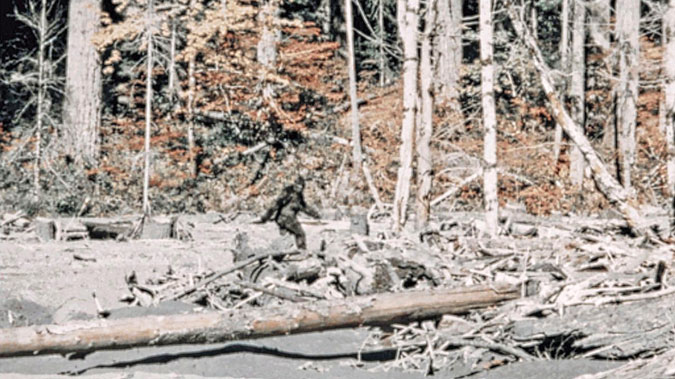
"Bigfoot" is an alleged species of ape/man-like creatures which have been seen by credible witnesses in the wilds of the North American continent, and all over the world, often leaving huge footprints and hair samples behind.
Introduction
double Bigfoot has been spotted in every state of the Union, except Delaware and Hawaii. There are organizations all over the country that keep track of information gathered on Big foot sightings and personal experiences with this creature. There have been so many sightings of this elusive creature, including castings of footprints, that more than a few people consider the evidence of its existence to be very strong.
Also known as "Sasquatch" by the Indians of British Columbia, "Oh-mah-ah" by the northern California Hupa tribe, "Skunk Apes or Napes" in the southern United States, as "Seeahtiks" in the Cascades, "Memegwico" by other American Indians, Yetis in Alaska/ Asia, and Almas in Russia, these creatures have been described as standing between six and nine feet in height, walking gracefully in an upright position, in smooth strides with knees bent. Their weight has been estimated to be between 300 to 600 pounds. They have muscular bodies, massive shoulders, and are covered with hair of varying length, depending on the account. Their facial features are humanoid, with the skin on their faces, hands and feet, dark and leathery. Their heads are peaked at the back. In some sightings they have jutted chins, heavy brow ridges, a receding forehead, and large, square white teeth. The female of the species has large breasts.
Family groups and individuals have been sighted and described so often in the Oregon-Washington area that both states have Bigfoot Informational Centers.
There are several theories as to how they should be categorized. Some think Bigfoot is a hominid variant.
"One thing we know for sure is that all known apes (Pongids) have a divergent large toe while Bigfoot does not," says investigator George Karras. "Bigfoot's tracks indicate that its feet more closely resemble the feet of Hominids such as Homo erectus or Homo sapiens (modern man) and hair samples that can not be positively identified more closely resemble human hair than the hair of apes or any other known animal. It is my opinion that bigfoot is not human but it is closer to human than any animal alive today."
Dr. Myra Shackley, a professor of archaeology at Leicester University, is convinced that bigfoot is a pre-hominid Neanderthal man, a predecessor of modern man, who supposedly was exterminated by Cro-Magnon man.
In the Altai Mountains of Mongolia, wild men known as Almas have been seen and known about by the area people for time immemorial. When modern people first settled the region, it is told how they drove the Almas out. Shackley visited the Altai Mountains and gathered evidence relating to their existence.
Dr. Boris Fyodorovich Porshnev, a Soviet historian who studied prehistory relating to the origin of man, investigated the case of a female Alma, described as having ape-like features and covered in hair, who was captured by the Altai Mountain people in the mid-nineteenth century. Called Zana, she eventually was domesticated and could perform simple tasks such as grinding corn. She loved grapes and wine, and after drinking heavily, would crash out for hours, which explains how she became pregnant several times. Her children, being half modern man, could talk and hold simple conversational exchanges with their human companions. The last of them died in 1954. Professor Porshnev interviewed her grandson, who had dark skin and Negroid features. His jaw was so strong that he could pick up a chair with a man sitting on it with his mouth.
Other theories have also been proposed.
One theory is that these are actually apes that escaped from captivity, chimpanzees or gorillas that once were the property of slave traders, and that they now inhabit the bottomlands of the United States.
Another theory, put forward by Loren Coleman, claims they are Apes from the "supposedly prehistoric family of the pongids, the Dryopithecinae," a species that was highly successful in living in both "temperate and subtropical areas." They could have come from Asia during the Pleistocene era over the now-submerged land bridge that once joined Russia and Alaska.
PHOTOGRAPHS
Hover your mouse over the pictures below for captions.
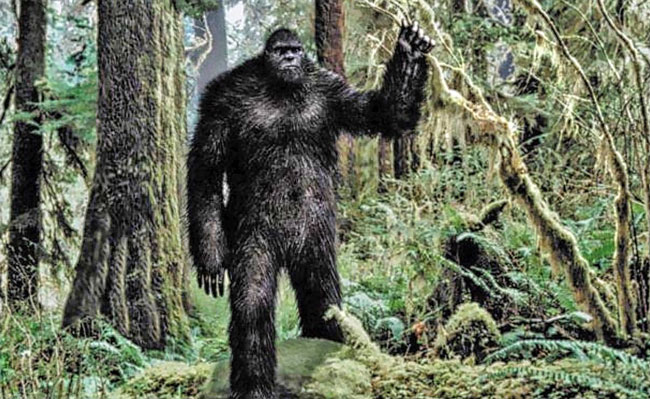
After her own personal encounter with the creature, a California woman sued the state and multiple state agencies, requesting the court order them to recognize Bigfoot as a mammal
indigenous to the area.
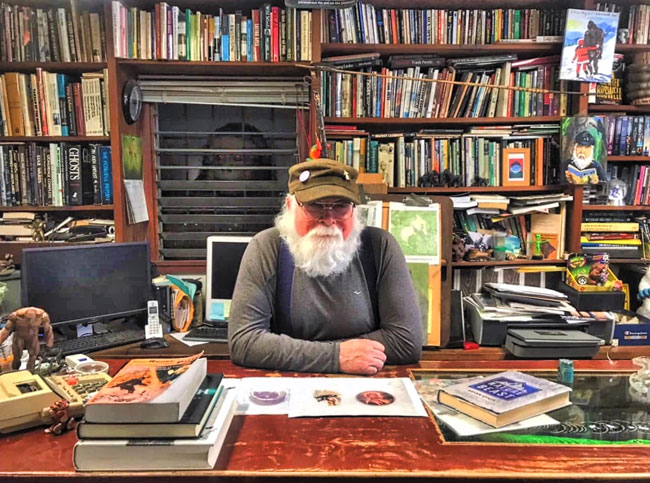
Michael Rugg is the curator of the Bigfoot Discovery Museum, in Felton, California. Far from being a kook, he's an erudite, evidence-seeking citizen scientist. Some consider him the Fox Mulder of Sasquatch lore.
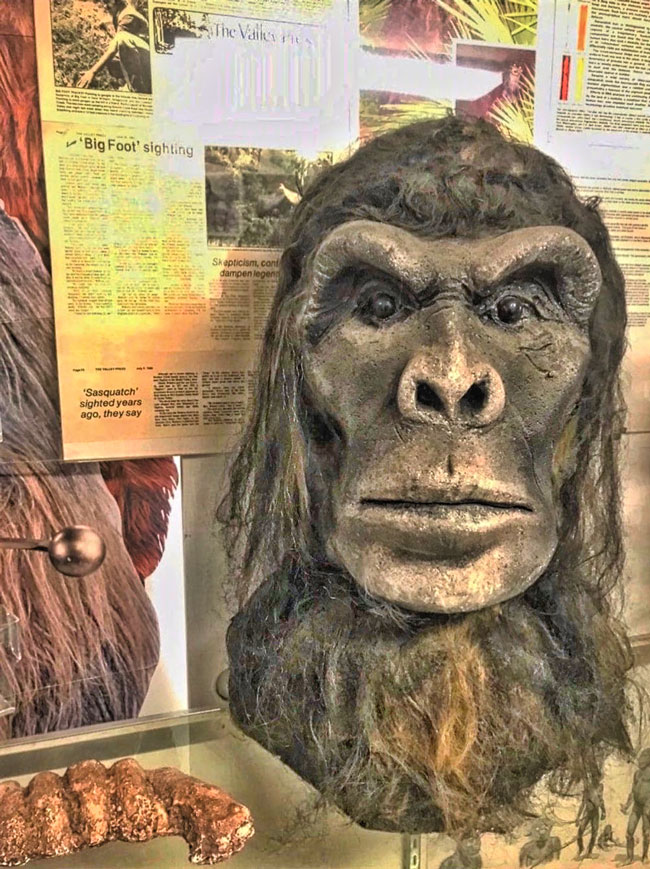
A bust of bigfoot in Michael Rugg's museum.
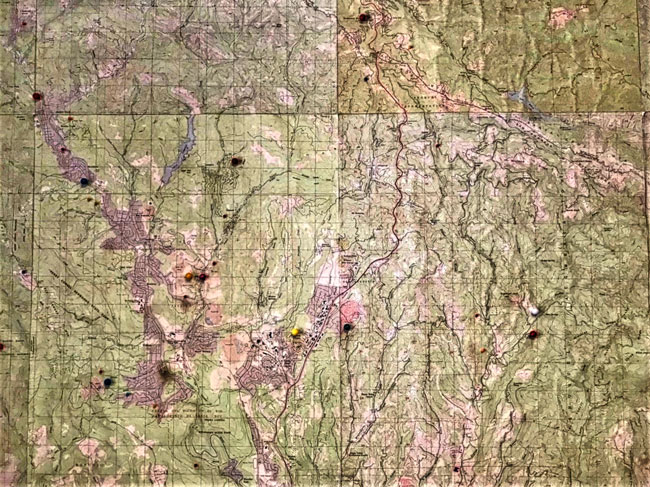
On a map hung on the wall of his museum, Michael Rugg has marked with multi-colored push-pins more than a dozen locations within Felton and its immediate surroundings where individuals have spotted the creature or evidence it left behind. He has documented more than 200 of them in the 90-mile stretch between Monterey Bay and Half Moon Bay.
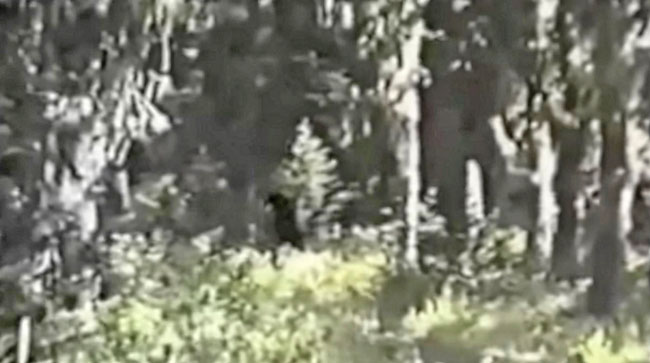
In 1994, former U.S. Forest patrolman Paul Freeman claimed he saw a family of bigfoots in Washington’s Blue Mountains. The video is shaky and grainy, but has been deemed the real deal by so-styled bigfoot experts.
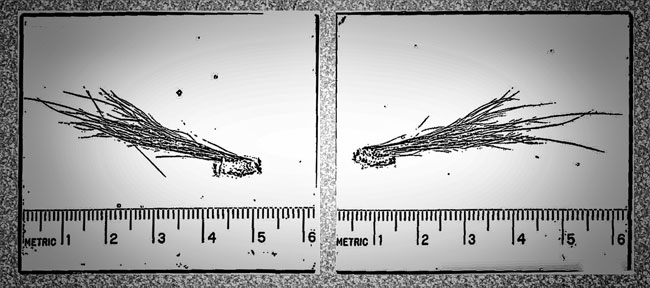
Director Peter Byrne of the Bigfoot Information Center and Exhibition in The Dalles, Oregon, sent the FBI “about 15 hairs attached to a tiny piece of skin.” Byrne wrote that his organization couldn’t identify what kind of animal it came from, and was hoping the FBI might analyze it. He also wanted to know if the FBI had analyzed suspected Bigfoot hair before; and if so, what the bureau’s conclusion was.

The FBI found that the hair didn’t belong to Bigfoot. In early 1977, the Bureau returned the hair along with its scientific conclusion: “the hairs are of deer family origin.” Four decades later, the bureau declassified its “Bigfoot file” about this analysis.
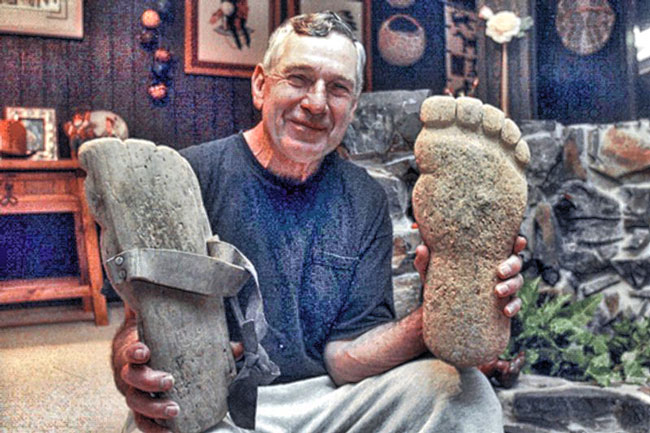
Folk Personality, writer, outdoorsman: Ray L. Wallace was the man who played a key role in creating the "Bigfoot" phenomenon. In 1958, with the help of his brother Wilbur, he carved 16-inch foot-shaped shoes to make tracks. The tracks were then cast by Ray and Wilbur, who wore them on their feet for use as they saw fit. In 1958 a man working for a construction company in Humboldt County, California, spotted the footprints and reported them to authorities, setting off a wide world legend.
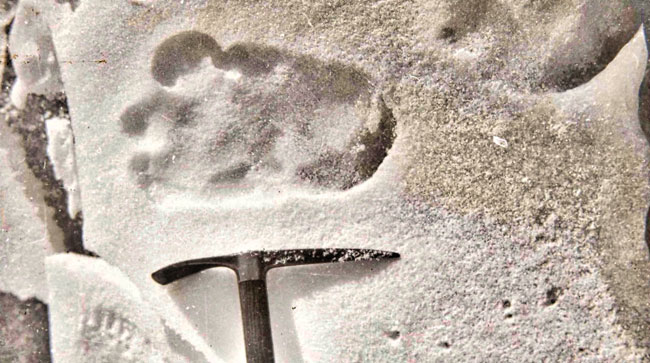
British explorer Eric Earle Shipton snapped this photo while trekking through the Himalayas in 1951, alleging that the footprint belonged to a Yeti. In 2014, Christie’s Auction house in London capitalized on the worldwide interest in bigfoot and sold the original photo for nearly $5,000.
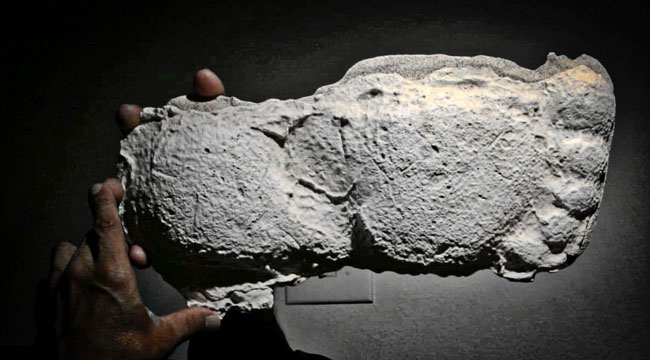
A cast of a foot track, obtained in Bluff Creek, California, at the Bigfoot Institute run by Daniel Perez.
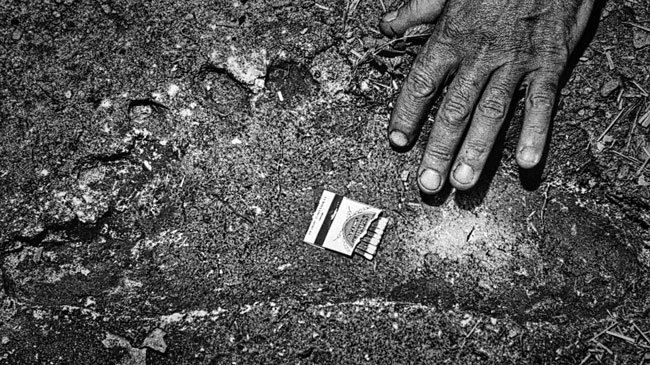
Locals in Johnstown, Pennsylvania, were baffled by a footprint measuring 17.75 inches found near a residential home in 1980. According to the Associated Press, the footprint coincided with reports of strange noises and a strong but unusual odor in the area.
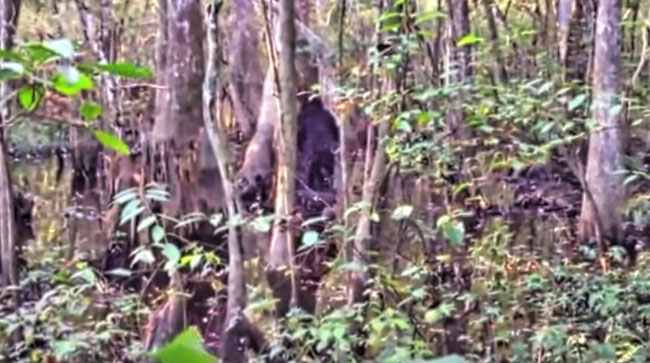
Mississippi resident Josh Highcliff captured video of this potential bigfoot while hunting on his property in 2013. Afraid to go back to the woods, he posted the footage to YouTube asking for help to identify the animal or for a prankster to come forward.
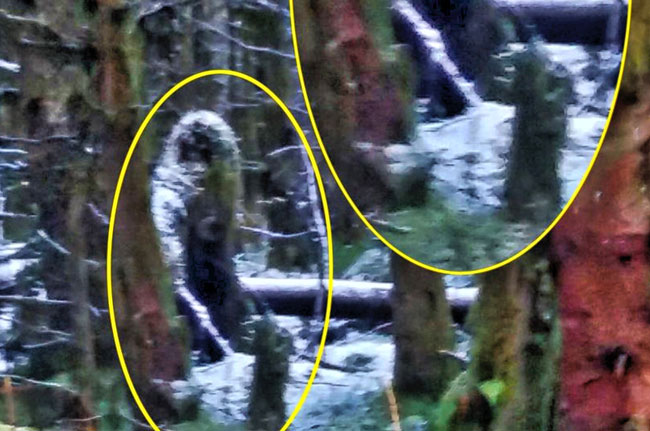
Many believe a spooky creature spotted in a Northern Irish forest by a woman walking her dog is Bigfoot. Others say it could be the ghost of passenger killed in a plane crash.
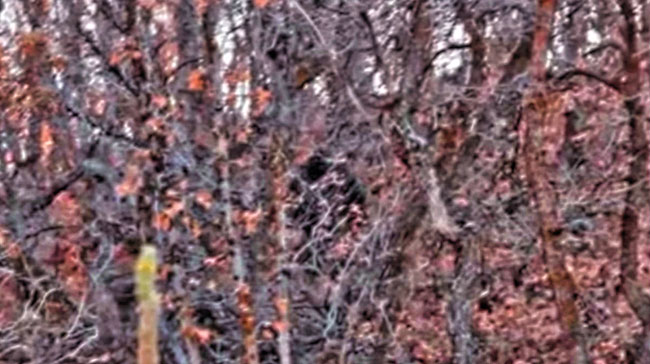
In October 2012, a group of siblings hiking in Provo Canyon thought they spotted a bear in the woods and started filming. When the creature stood up on two legs, the hikers ran—abruptly ending the shaky video. A year later, the siblings launched a kickstarter campaign to investigate other Utah bigfoot sightings.

In 2007, hunter Rick Jacobs captured some of the most famous bigfoot images to date with a camera mounted to a tree in Pennsylvania’s Allegheny National Forest. His camera also captured clear photos of bear cubs, offering evidence that the unidentified animal was not ursine. But skeptics believe the animal is just a bear sick with mange.
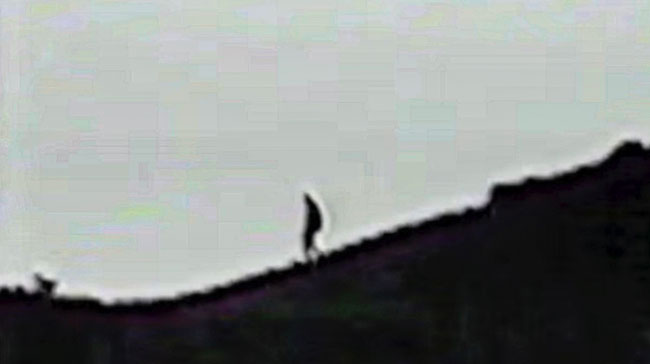
A youth group was camping in the Marble Mountain Wilderness when leader Jim Mills noticed a strange-looking creature skulking along a ridge nearby. He filmed it for nearly seven minutes, making the somewhat-grainy footage the longest video of an alleged bigfoot sighting.
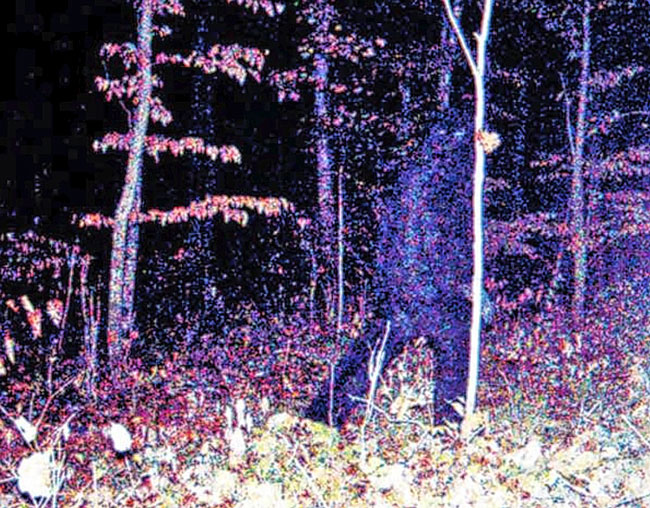
Casey Kedrowski's trail cam caught this image of a tall, fuzzy creature near his family's hunting shack in Remer, Minnesota.
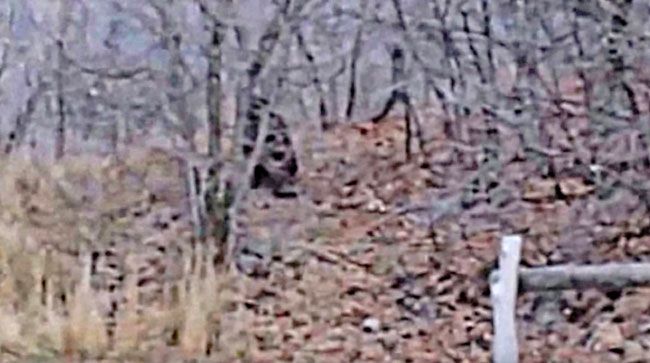
A hiker was walking through the Utah Hills near Provo Canyon in 2012 when he spotted a large animal in the woods. As he approached, the animal stood up on two legs and started throwing rocks at him — supposedly a trademark behavior of Sasquatches.
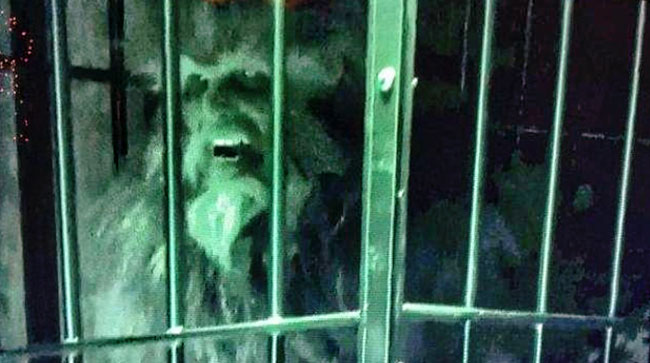
No, a Bigfoot creature was not captured in the course of a History Channel program. The show was yet another fake "documentary" created for entertainment purposes.
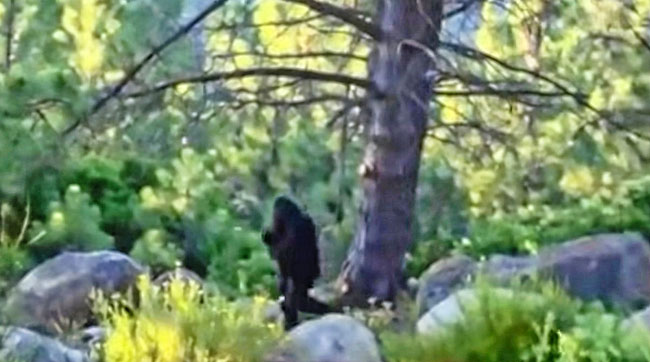
Called “The Independence Day” film, this remarkably clear video shows an alleged adult bigfoot walking through the woods, with a cub in tow. The filmmaker and exact location are unknown, and many skeptics claim that there is a telling visible seam of a gorilla suit.

In the Altai Mountains of Mongolia, wild men known as Almas have been seen and known about by the area people for time immemorial. When modern people first settled the region, it is told how they drove the Almas out.
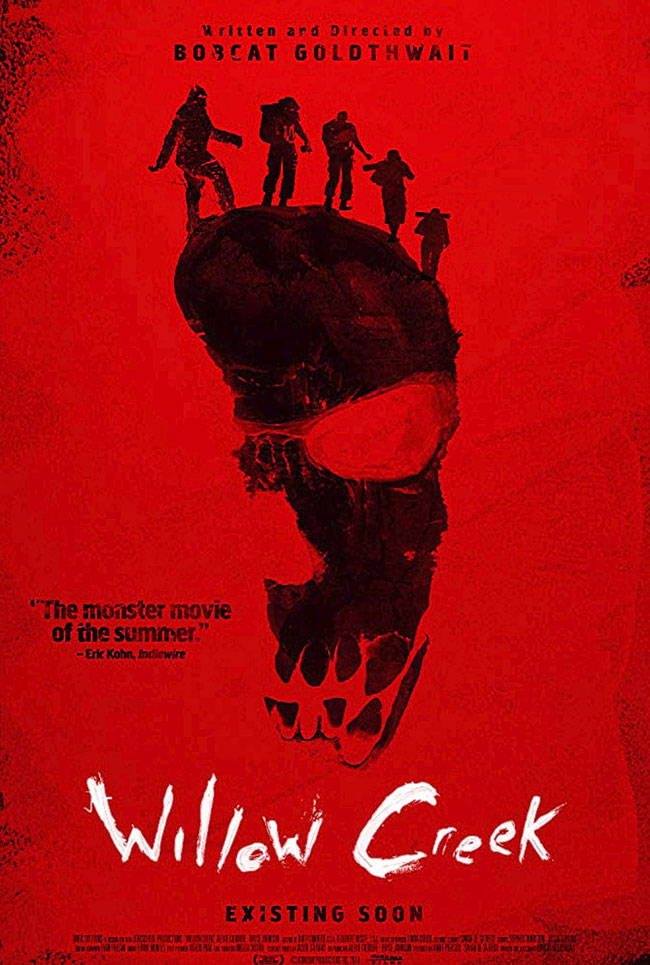
From celebrated director Bobcat Goldthwait comes this edge of your seat horror that will make you think twice
before going into the woods.
Jim and his girlfriend Kelly are visiting the infamous Willow Creek, the alleged home of the original Bigfoot legend — the tale of huge ape like creatures that roam the forests of North America. It was there that in 1967, the legendary beast was captured on film and has terrified and mystified generations since.
IMDb web page

Calvin Barr, an old, bitter recluse and one-time assassin for the US government is asked to come out of retirement for one final top secret mission — to track down and eliminate a Bigfoot infected with a deadly disease that could spread to others if the creature remains on the loose.
IMDb web page
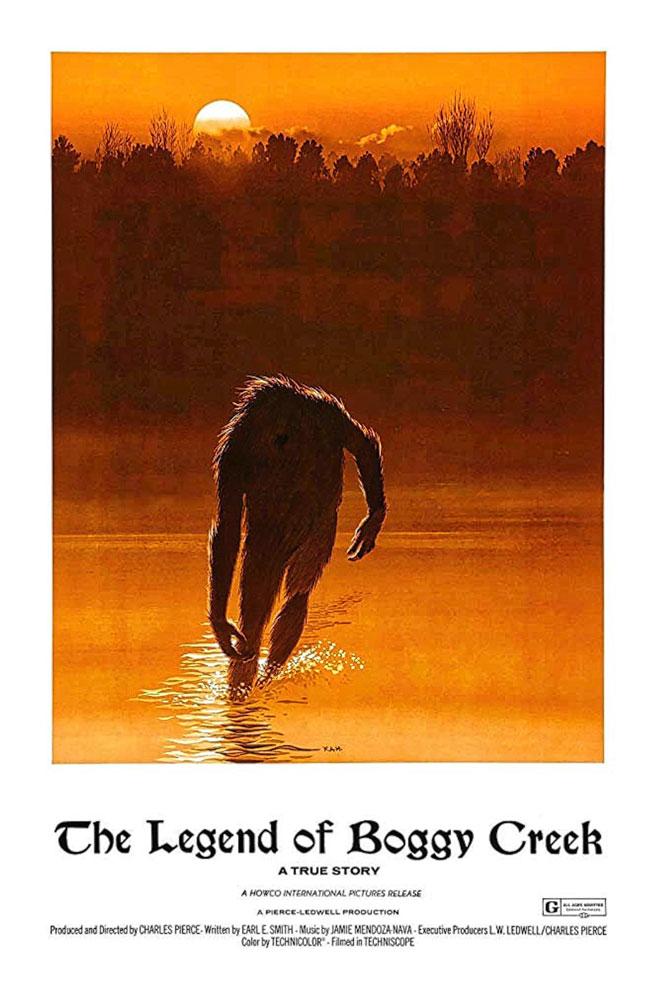
In the lush backwoods region of Texarkana, Arkansas, local men scorn the legend of the Fouke Monster, named for the 350-person town in which it has been spotted — a giant, three-toed, Sasquatch-like creature. Jim, a seven-year-old country boy, is sent by his mother to get help from town after she spots the monster near her house.
IMDb web page

Returning from a hunting trip in the forest, the Henderson family's car strikes an animal in the road. At first they fear it's a man, but when they examine the body they find it's a bigfoot. They think it's dead so they decide to take it home (there could be some money in it). As you may imagine "it" isn't dead. And far from being the ferocious monster they fear it to be, he turns out to be a friendly giant. In their attempts to keep Harry a secret, the Hendersons must hide him from the authorities and from a man who's made it his goal in life to catch a bigfoot.
IMDb web page
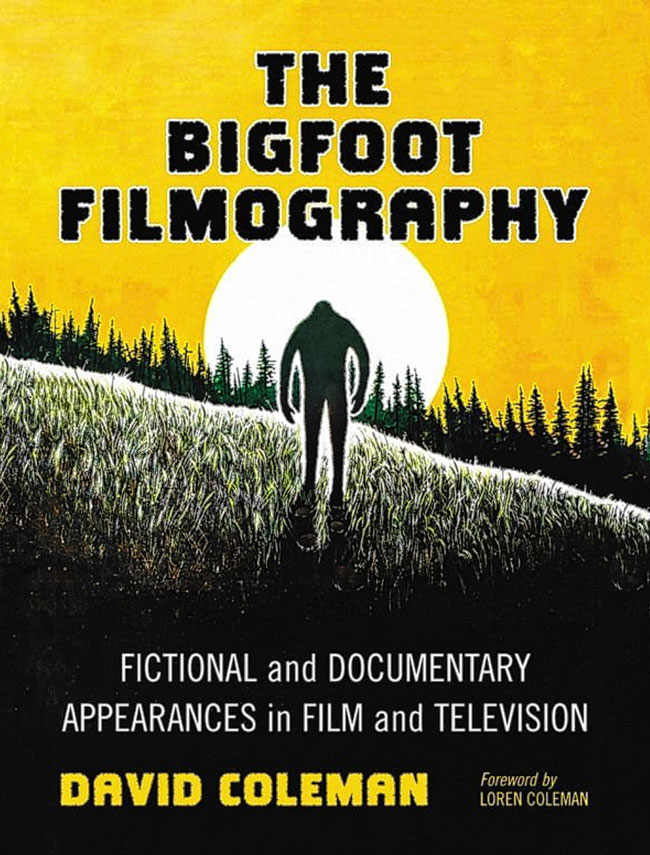
The Sasquatch film genre, devoted to the legendary and notoriously elusive creature also known as Bigfoot, and its Himalayan counterpart, the Yeti, is the focus of this illustrated reference guide. Here is a fascinatingly detailed look at the cinematic history of Sasquatch, from the earliest trick films of Georges Melies to the most up-to-date CGI efforts. Critical insights regarding the genre's development are offered, along with an exhaustively researched filmography that gathers every known film or television appearance (including ads!) of Sasquatch, Bigfoot and Yeti in both fictitious and documentary formats. Included are in-depth interviews with such filmmakers as Kevin Tenney, Adam Muto, Ryan Schifrin, Tim Skousen and Michael Worth, as well as reproductions of rare movie stills, posters, lobby cards and behind-the-scenes production photos. Renowned cryptozoologist Loren Coleman (no relation) provides an insightful foreword.
Includes over 200 rare photos, posters and other collectible images. Superior, high-quality photographic reproductions on premium paper stock. Softbound.
Amazon web page

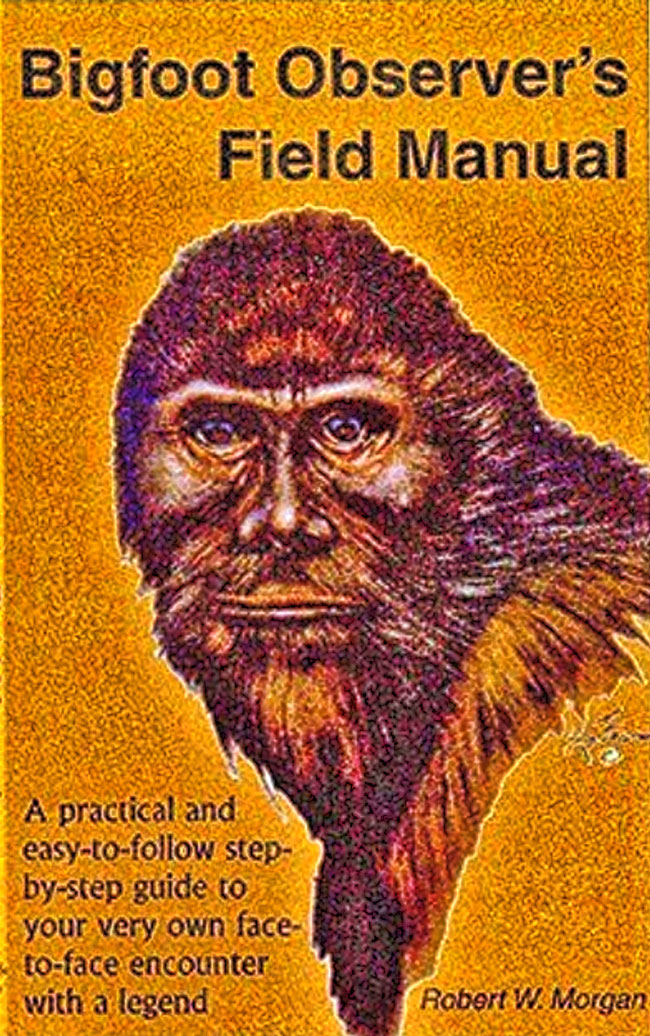
Robert W. Morgan is one of the first persons to seriously investigate and research the mystery known as Sasquatch, or Bigfoot. Robert has spent many years conducting active Bigfoot field research, and he has amassed a considerable amount of knowledge and wisdom.
This book is for serious people wanting a face-to-face encounter with a legend. Robert gives the reader a step-by-step guide to follow.
Since he saw his first Sasquatch in 1957 in Mason County Washington, Morgan has traveled the world seeking more information about the beings he calls Forest Giants.
His search has led him to Native Americans and their legends, a Tibetan lama, and expeditions to the forests of Washington State, sometimes alone, sometimes in groups. He has had encounters with these beings, which he believes are true human beings.
Morgan resides in Whitefish, Montana, where he spends the winter months writing. Summertime is reserved for more adventures.
Amazon web page
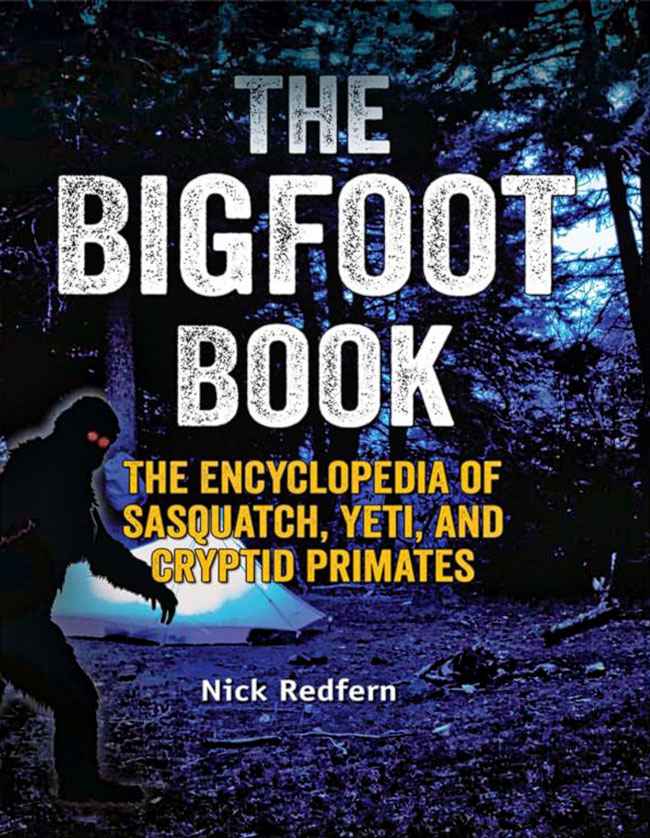
The definitive guide to Bigfoot, Sasquatch, Yeti, and other man-primates from an established author and respected expert on the unexplained and paranormal.
Does a hulking, hairy, 800-pound, nine-foot-tall, elusive primate roam the woods and forests throughout North America—and the world? What should we make of the grainy videos and photos and the thousands of eyewitness reports? Audio-recordings exist purporting to be the creatures’ eerie chatter and bone-chilling screaming. Whether called Sasquatch, Yeti, Bigfoot, or something else, bipedal primates appear in folklore, legends, and eyewitness accounts in every state of the union and many places around the world. The fascination with the man-beast is stronger than ever in today’s pop culture.
Exploring the history, movies, and literature, the conspiracy theorizing, and the world of the supernatural, The Bigfoot Book: The Encyclopedia of Sasquatch, Yeti, and Cryptid Primates is a comprehensive resource to the man-beast. With nearly 200 entries and 120 photographs, drawings, and illustrations, it is the definitive guide to understanding, hunting, and avoiding the brute, as well as discovering the facts behind the sightings and horrifying tales. It covers 400 years of folklore, mythology, history, and pop culture, including Native American lore, the “wild men” reports in the pages of 19th century-era American newspapers, Florida's Myakka Skunk Ape, Australia's Yowie, China's Yeren, Himalayas’ Yeti, Russian expeditions, Harry and the Hendersons, Exists and the countless movies titled Bigfoot, as well as specials on the television shows Animal Planet, Discovery Channel and National Geographic Channel, scientific reports and findings, and much, much more.
Amazon web page

"Here there be dragons"
— This notation was often made on ancient maps to indicate the edges of the known world and what lay beyond. Heroes who ventured there were only as great as the beasts they encountered. This encyclopedia contains more than 2,200 monsters of myth and folklore, who both made life difficult for humans and fought by their side. Entries describe the appearance, behavior, and cultural origin of mythic creatures well-known and obscure, collected from traditions around the world.
Amazon web page
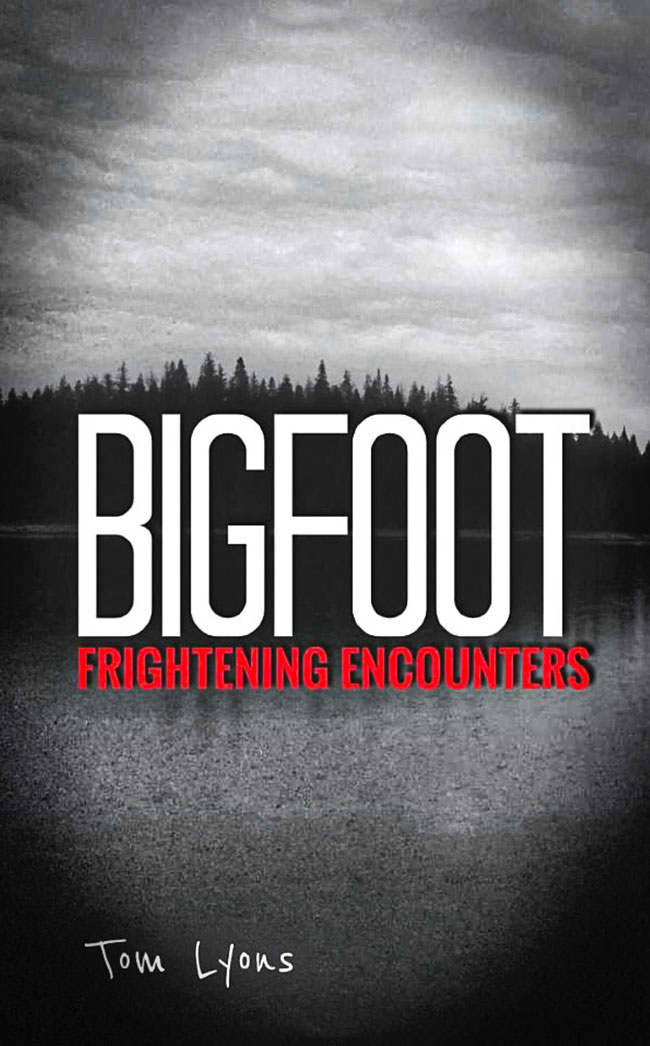
Following the release of his best selling series, "Living Among Bigfoot", author Tom Lyons was contacted by several individuals who were eager to discuss their own encounters with the mysterious Sasquatch species. After realizing how cathartic it is not only to share his own experiences, but also to hear the encounters of others, he compiled this volume with the help of many folks who were brave enough to share their life-altering stories. This book also features never before seen photos of the Sasquatch species, submitted by an individual who resides in Catalonia. NOTE: The photos are displayed in color only in the eBook edition, however the eBook is free to download with the purchase of the paperback.
Amazon web page


























































